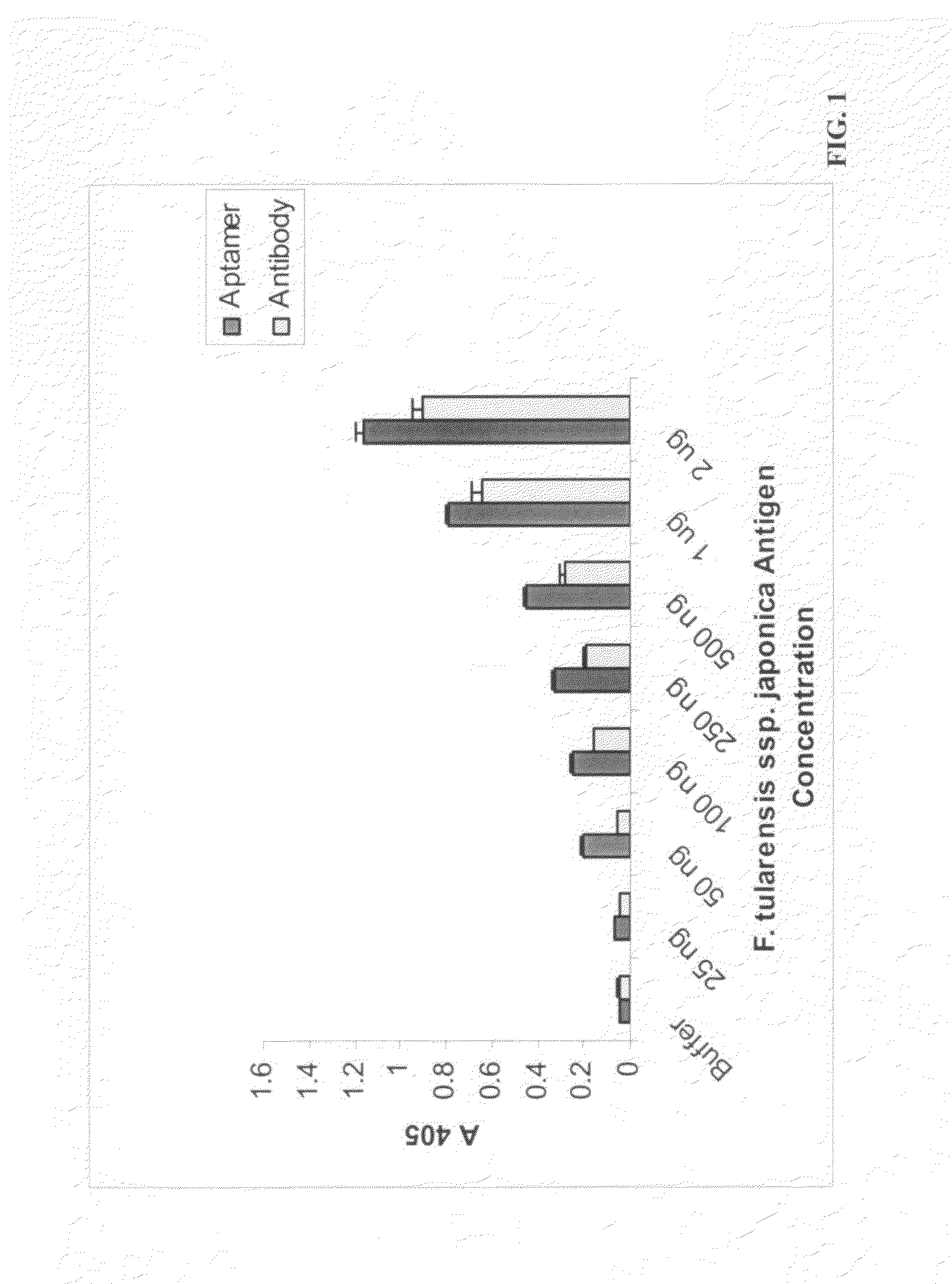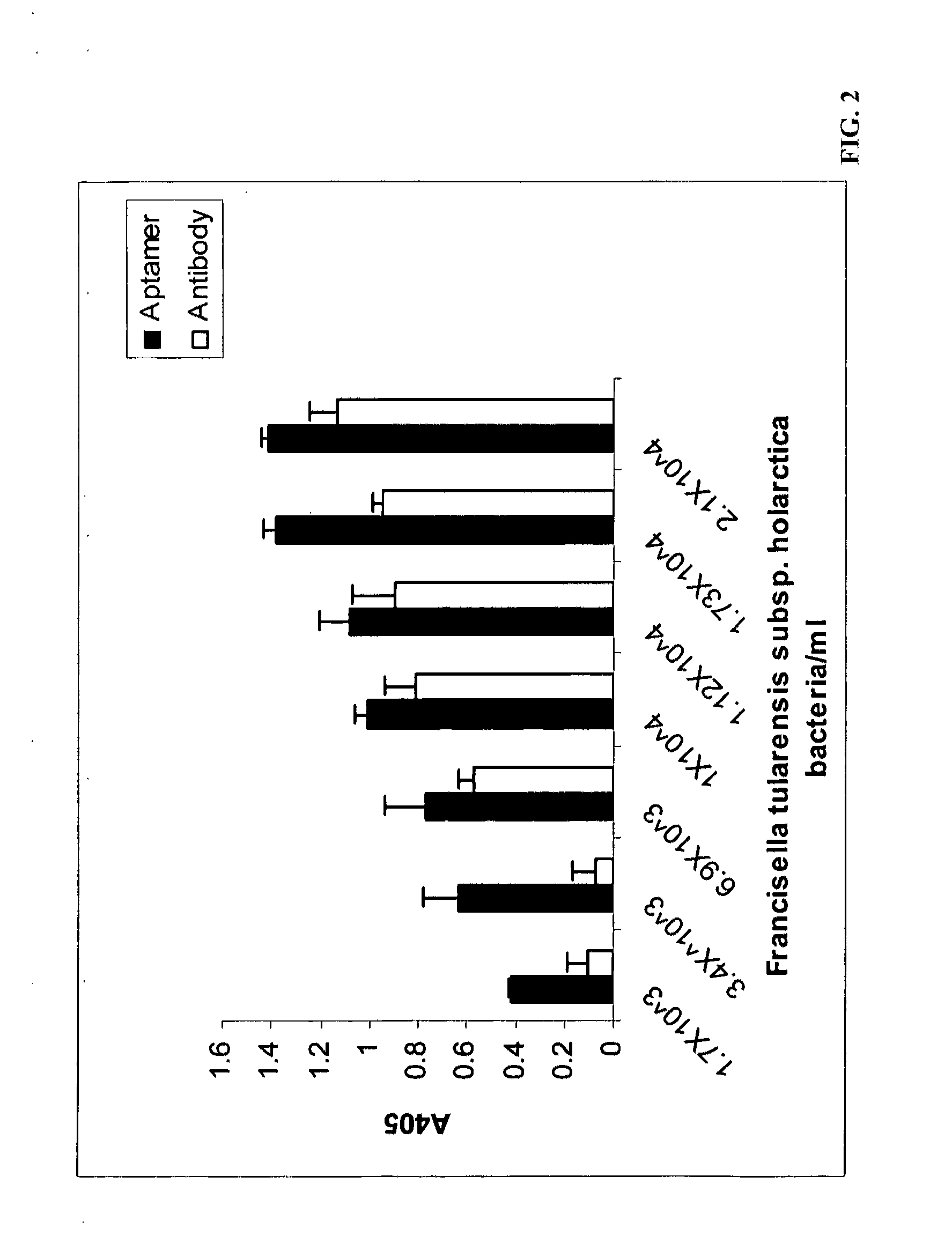Aptamer-based assays
- Summary
- Abstract
- Description
- Claims
- Application Information
AI Technical Summary
Benefits of technology
Problems solved by technology
Method used
Image
Examples
example 1
Antitularemia Aptamer Cocktail
[0015]We isolated and used aptamers of the following sequences:
SEQ ID NO: 1. FTJ-01:5′ TAA CCA CAA CCT TAC CAA CGA ATAGAT TCA CCT CTC CCC ACA 3′SEQ ID NO: 2. FTJ-02:5′ AAA CAC ACA TAC CAA TAC CCA TCACAT TAC TGA ACT CCA ACC 3′SEQ ID NQ: 3. FTJ-03:5′ AAA TTC ACT CAC TAT AAA ACC CTCGAC ATC TAA CCC CCC AAC 3′SEQ ID NO: 4. FTJ-04:5′ GCC ATA ATA CAC CCC GCT CAC CTCGTA TAT TCC TAA CTC CCC 3′SEQ ID NO: 5. FTJ-05:5′ ACC CTA ACT AAC TTC ATT ATT TCCCAC TGG AGG TAC GAA GAT 3′SEQ ID NO: 6. FTJ-07:5′ TAT AAC ACT CCC CAT ACA TATACT CGA TAT CCA CCT ACA GCA 3′SEQ ID NO: 7. FTJ-08:5′ ATT ACA TCC TCG ACA TAA ACC ACACGC TCA ACA CAA CCC TGA 3′SEQ ID NO: 8. FTJ-09:5′ ACA CTC TAA CTC AAA TCG ACT TCCTCG AAA 3′SEQ ID NO: 9. FTJ-11:5′ CAA TTT TCC GTC CTT ATT TAC TTTTAA TTC TCA GCA CCC GAA 3′SEQ ID NO: 10. FTJ-12:5′ TCA CCA ACT ACA ATT ACT CAT CTCCCT ATA AGT TCC CCA TCA 3′SEQ ID NO: 11. FTJ-13:5′ AAC AAT ACT TAA TAC TGC TTC CCACAC TCT CAT CGC CCC GTA 3′SEQ ID NO: 12. FTJ-14:5′ CA...
example 2
Aptamer-Linked Immobilized Sorbent Assay
[0023]This example involved an ELISA-like format diagnostic system for the diagnosis of tularemia in clinical samples or the presence of Francisella tularensis in environmental samples using aptamers instead of antibodies for capturing and reporting the presence of the tularemia bacteria. Twenty-five unique DNA sequence aptamers were used for this purpose on a microtiter plate platform. Possible uses include diagnosis of tularemia infection in military personnel or exposure (from environmental samples) to this biological agent, as the result of a biowarfare, bioterrorism, or natural exposure event. Another possible use is diagnosis of natural infections of tularemia in a hospital setting. One purpose of this example was to construct an aptamer-based, ELISA-like assay (ALISA) to replace the current immunoagglutination and antibody-based ELISA assays for the diagnosis of tularemia. A highly durable, reliable field test that minimizes secondary i...
example 3
[0036]Materials and Methods: Dot Blot Analysis with Aptamers and Antibodies.
[0037]Fifty μg of bacterial lysate from F. tularensis subspecies holartica, #38 isolate and tularensis (SCHU 4) were spotted onto nitrocellulose membrane discs and allowed to air dry. These samples were fixed under vacuum at 80° C. for 1 h and blocked with 5% BSA in PBS. One batch was incubated with biotin-labeled aptamer cocktail at 500 pmol / disc in binding buffer (20 mM Tris-HCl, pH 7.5, 45 mM sodium chloride, 3 mM magnesium chloride, 1 mM EDTA, 1 mM DTT) for 1 h at room temperature with gentle rocking. The other batch was probed with anti-tularemia rabbit IgG (Becton-Dickinson and Company) in PBS at a dilution of 1:1000 for 1 h. After the designated time, both batches of membrane discs were washed with PBST three times and probed with streptavidin-conjugated alkaline phosphatase (Pierce Biotechnology, Rockford, Ill., USA), and goat anti-rabbit IgG-conjugated alkaline phosphatase (Pierce Biotechnol...
PUM
| Property | Measurement | Unit |
|---|---|---|
| Affinity | aaaaa | aaaaa |
Abstract
Description
Claims
Application Information
 Login to View More
Login to View More - R&D
- Intellectual Property
- Life Sciences
- Materials
- Tech Scout
- Unparalleled Data Quality
- Higher Quality Content
- 60% Fewer Hallucinations
Browse by: Latest US Patents, China's latest patents, Technical Efficacy Thesaurus, Application Domain, Technology Topic, Popular Technical Reports.
© 2025 PatSnap. All rights reserved.Legal|Privacy policy|Modern Slavery Act Transparency Statement|Sitemap|About US| Contact US: help@patsnap.com



